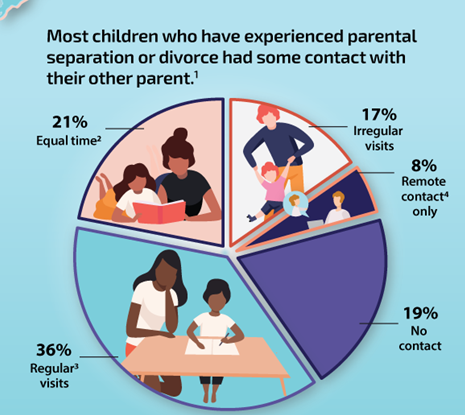Oct 2, 2023 – ESP Stats

Surprising implications from a Statcan report as per George Piskor
(extracted from STATCAN report)
https://www150.statcan.gc.ca/n1/en/pub/11-627-m/11-627-m2022018-eng.pdf?st=J1SzhdgU
In case you no longer wish to receive the “Gene C. Colman Family Law Centre Equal Shared Parenting Thought of the Day” emails, you can easily unsubscribe at the bottom (and I apologize for the intrusion).
Gene C. Colman Introduction: We turn the platform over to George Piskor for today’s ESP Thought of the Day. George analyzes some Statcan data. Enjoy.
Here’s some data from Statistics Canada on the prevalence of shared parenting derived from the 2019 Canadian Health Survey on Children & Youth that suggests the prevalence of shared parenting may be higher than we thought (at least among divorced couples)
The data indicates that 21% of divorced couples (the survey did not address common law or civil unions) have equal time arrangements with another 36% with regular visits (defined as “for example, every week, every two weeks of every month). Allowing for an admittedly loose interpretation of “regular visits”, this allows the inference that 57% of children are in a shared physical custody arrangement of at least 14% parenting time.
We know that shared parenting stats are imprecise due to lack of good data along with varying definitions of the threshold for shared parenting. Nonetheless, let’s compare with stats provided in the 2022 paper by Bala and Ebsim,” The 2021 Canadian Parenting Reforms: Is Shared Parenting the New Normal?” which summarizes the best shared parenting stats in Canada:
1. 2017 General Social Survey, “Statistics Canada, using a weighted formula, used these results to conclude that the 53% of children were in a shared custody living arrangement, though recognizing in a footnote that there are concerns about the reliability of this figure.” That’s pretty close correspondence.
2. “Reported Canadian Contested Decisions (2015)
A study of reported judicial decisions in 2015 in Canada on the Westlaw found that 22% of the reported decisions resulted in shared custody.11 There was substantially less use of shared custody in Ontario (14%), a province that continued to use the “custody” and “access” terminology in its legislation at the time of the study. Notably, even though this data set represents a relatively high conflict group, given the cases were litigated and decided by a judge, there were high rates of shared custody in British Columbia (22%) and Quebec (30%), jurisdictions where the provincial statutes had at that time abandoned the custody and access terminology.
This study reveals that, at least in 2015, Ontario judges were reluctant to impose shared custody.”
Given that these cases represent a relatively high conflict group, that suggests that 22% can be reasonably interpreted as a lower estimation limit nationally with regional variation in the 14%-30% range.
3. Survey of Family Lawyers (2018)
“In a 2018 survey completed by 612 Canadian family lawyers, 93% of lawyers reported that three-quarters of their cases involved shared physical custody arrangements (operationalized as at least 40% of time with each parent).”
Assuming that 25% of the cases had worst-case 0%, this allows the inference that .93 x 75% =70% of divorce cases have shared physical custody of at least 40%. This is truly an amazingly high number which we would all like to believe but strains lived reality.
4. Survey of Selected Family Courts (2018-19) (sampled in Manitoba, Saskatchewan, New Brunswick, Prince Edward Island, and Yukon” so represents a skewed sample in smaller provinces)
“… shared custody (at least 40% of tie with each parent) was awarded almost one third (31%) of the time.”
IMV, despite the imprecision and variability, it seems that it is not unreasonable to infer from the above that Canada has an average 30% (+/- 8% subjective range) prevalence of shared parenting of a minimum of 30% parenting time among divorced couples. If so, that would place Canada among the top tier of shared parenting countries.
I caution that this guesstimate applies only to divorced couples as we know that shared parenting rates are lower for common-law and cohabitating couples in all jurisdictions (although Quebec may well be an outlier in that regard).
Some musings,
George Piskor
International Council for Shared Parenting (ICSP) – Board Member & Scientific/Communications Committee
National Parents Organization (NPO) – Board Member
Equal Shared Parenting Working Group (ESPWG) – Member
Canadian Equal Parenting Council (CEPC)- Ex-President
Gene C. Colman comments further
Link to Gene C. Colman’s Equal Shared Parenting Web Page
Link to past issues of the ESP Thought of the Day publication




